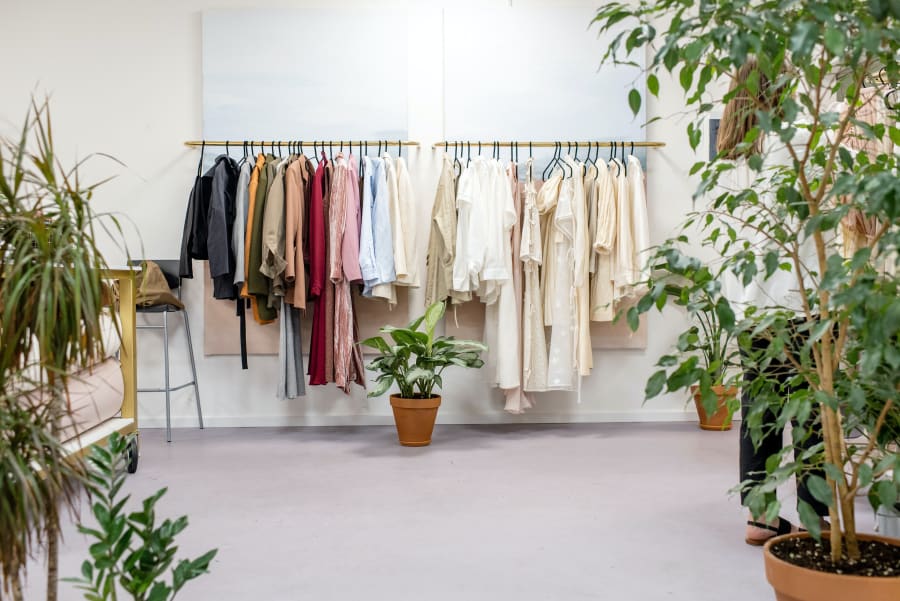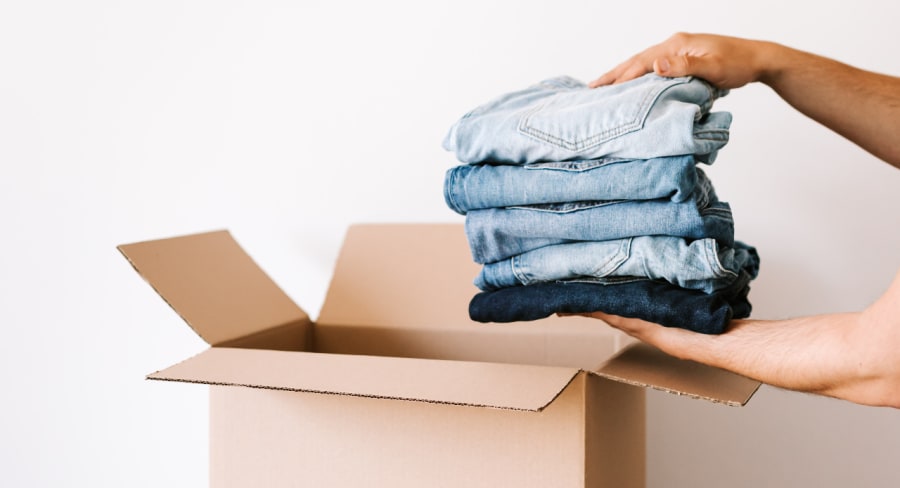Maybe you’re preparing to return to in-person work. Perhaps you came back to the office months ago. Or maybe you’ll be doing some combination of remote employment and in-office days, balancing Zoom calls from your living room with occasional or semi-regular physical appearances.
Regardless of what your circumstances entail, it’s probably time to change out of those sweatpants you’ve been lounging in for the past year, are we right?
Recommended Videos
And if that’s the case, what should you wear? Do you need to go shopping? Where do you start?
We asked an expert: In this case, Paulina Petkoski, a fashion stylist, creative consultant and designer -- who’s also an adjunct professor at the College for Creative Studies, where she’s developed a course, along with being a co-owner of the gallery Playground Detroit.
Petkoski is passionate about responsible shopping. Around 2009-10, she even started a sustainable fashion brand. There’s not simply one solution or method to be sustainable, she said. We’ll touch on some of the ways you can make a difference throughout this piece.
So, back to business: You’re returning to the office, or you already did, and you’re wondering if your wardrobe is OK, or how you might be able to improve it. Here’s some advice from Petkoski:
1. Start by assessing what’s already in your closet.
And if you’ve been procrastinating when it comes to this step, there’s no better time than the present to dive in.
“I would hope people would have done (some) internal cleanups during quarantine,” Petkoski said. “So if you didn’t start (then), start in your closet now. Get rid of the stuff that you know isn’t working -- out of sight, out of mind. This clears your ability to see what you do have. If it’s in bad condition, it’s outdated or it doesn’t fit, get rid of it.”
Admittedly, this might be a big job. It’s easy to feel overwhelmed by the task. You can ask a professional to come help. That’s part of what Petkoski does for work. Serving as a freelance stylist, she’s even able to do it remotely -- meeting with people on Zoom and coordinating the online shopping that will follow.
“But this is where we start,” Petkoski said. “Before we go shopping, we have to see what you have, what you need to replace, and what you’re missing.”

2. Consider your personal situation and the trends.
If you had to work from home during the pandemic, Petkoski used the term “above the keyboard dressing” to refer to what a lot of us were doing: Building waist-up outfits, since that’s how we were visible on Zoom or other conference-call apps.
If you’re still working remotely, or this is the first time you’re thinking about how you can improve your WFH style, Petkoski recommended focusing on accessories: Adding in earrings or necklaces that would show up on your webcam.
Hoop earrings are back, and many people are wearing them these days in all sizes, both silver and gold. Metal chain-types of necklaces are in too, and you can style those in whatever way best suits your look -- whether that means classic, trendy or edgy.
Lean in, and have some fun with those accessories!
Petkoski said when it comes to dressing from the waist up, it’s best to avoid crazy patterns.
And as for in-person, full-body looks, she’s been shopping with some of her clients at places like Saks Fifth Avenue. Petkoski mentioned a soft blazer she recently found (and loved) from the brand Theory.
“It’s about translating the comfort in your home back into the office and your everyday life,” she said.
For women, she recommended looking at two-piece sets, such as a skirt and a top, or a sweater and a skirt that’s thicker-knit, going into the fall.
M.M.LaFleur is another brand she loves. It packs and travels well if you have business trips on the horizon, and it’s great for a more traditional office setting.
If you’re going for the soft blazer look, try ones made of jersey or a knit material, Petkoski said. They make for a professional appearance, but they’re not uncomfortable. That’s important after spending a year in sweatpants.
3. And as for your old things ...
If it’s a standard, name-brand item and it’s not damaged, Petkoski said she recommends signing up for threadUP. “It’s my favorite,” she added.
Here’s how it works: thredUP is an online consignment and thrift store where you can buy and sell high-quality secondhand clothes.
Go to this site and the store will send you a big bag. You’ll go through your closet, fill your bag with whatever you no longer want, ship it to the company free of charge, and then they’ll review your items.
threadUP will list your old clothes for you, sell your things on the marketplace, and you’ll get a store credit. When you’re shopping for your new items, you can sort by brand, size and color -- threadUP makes it easy for you to find what you want, Petkoski said, adding that it’s not so much intended for vintage or high-end luxury pieces; it’s more so the mass moderate market: J Crew to Kenneth Cole.
“It’s a great place to start,” Petkoski said. “You’re getting rid of your stuff responsibly, and (if it doesn’t sell), they donate responsibly on your behalf. … And then you have credit to start buying new items. You’re translating your current wardrobe into funds. It’s one of my favorite personal ways to shop. It’s really cheap and they tell you the original prices.”
Or if you know of a spot in your local area where you feel comfortable donating your old clothes, you could always do that, too. Petkoski even suggested organizing a clothing swap with your friends, if you can all get together in person. It’s fun, and the “shopping” is free.

This sort of idea falls into the circular economy, and keeps things “in the loop,” which is preferable to everyone in your friends group continuing to buy new things.
And speaking of the economy and the planet, that brings us to more sustainability talk. Here’s what else Petkoski had to say.
4. ‘Stop shopping fast fashion.’
Fast fashion, by the way, includes stores like H&M, Zara and Forever 21. You can probably figure it out from the name: They’re sometimes stylish pieces, but they’re often cheap and you won’t keep them around for long.
“(And) we can’t afford it for the planet,” Petkoski said.
Think about the things your mother or grandmother might have left to you, or will leave in your name someday.
“Would you want to leave your Forever 21 jacket to your daughter?” Petkoski asked. “You’re building a wardrobe for your life -- that fits your lifestyle. It can change, but your clothes should be high-quality enough to resell.”
Investing in pieces that will last is so much better than buying clothing that you’re just going to discard in a few months or a year. This is yet another reason why you should consider threadUP, or other second-hand markets, rather than continuing to buy cheap.
“The second-hand market is actually set to surpass the mass fashion market,” Petkoski added.
And the mass fashion market has been king for quite some time -- so this would mark a huge shift. There’s likely $1 billion to $1 trillion in untapped value there, in garments that could be available through the second-hand market, that aren’t just yet. This could be big moving forward, Petkoski said.
5. Read your labels.
If you’re replenishing your wardrobe, look at where your pieces of clothing are being made -- and what they’re being made from. Is the fabric coming from natural fibers?
Ideally, you want to wear these natural fibers, such as cotton, linen, wool or lyocell, Petkoski advised.
There are some new fabrics emerging, like recycled polyester, made from recycled water bottles or plastics. Those are becoming more and more available, which is great for sustainability. It’s best to avoid synthetics or blends like cotton-spandex -- as they’re bad for our water (like when you wash these materials), the ocean and the environment as a whole, Petkoski said.
It all comes down to making better choices with your purchases; for yourself and the planet.
As for how many things to keep in your wardrobe, there’s really no one-size-fits-all answer.
Some people want a lot of pieces, and some just want a few. It also depends on if your weight fluctuates, and you like to keep an array of sizes, or whatever your personal circumstances or preferences might be.
Petkoski estimated that in an average person’s closet, 70% of the contents aren’t used regularly, so maybe it is smart to reduce.
“Especially if you have a busy lifestyle -- it makes getting dressed more simple,” she said.
It’s kind of like the idea of having a “uniform” or something you wear often, so that you don’t have to put in as much daily time and effort. If that sounds like something that appeals to you, that might be a great idea.
But ultimately, the choices are yours: Hopefully we’ve equipped you with a few things to think about, moving forward, when it comes to dressing for work.
Have a question about sustainable fashion or your wardrobe? Drop it in the comments below, and we might use it as inspiration for a future news story.



